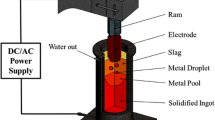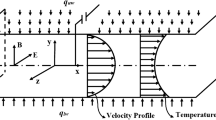Abstract
Through the statement of Maxwell's equations, the turbulent Navier-Stokes equations, and the convective heat balance equation, a mathematical model has been proposed for the Electroslag Welding Process. In the formulation, allowance has been made for both electromagnetic and buoyancy forces for driving the slag and the metal flow. The principal finding of the work is that convection in the molten slag region has a marked effect on the heat transfer process. For a rectangular geometry, using plate electrodes, the flow field is driven by buoyancy forces, the circulating flow is less intense, and the thermal efficiency of the process is improved. In contrast, for wire electrodes (approximated by a cylindrical geometry) the flow is driven by electromagnetic forces and a substantial part of the thermal energy is dissipated to the plates.
Similar content being viewed by others
References
B. E. Paton:Electroslag Welding, American Welding Society, New York, 1962.
D. N. Shackleton,et al:Research Developments in Electroslag and Electro-gas Welding, Rev. Soudre.vol. 41, no. 1, p. 1, 1975.
John Barsom: U.S. Steel Corporation, Monroeville, Pa., unpublished research, private communication, 1976.
A. H. Dilawari and J. Szekely:Met. Trans. B, 1977, vol. 8B, pp. 227–36.
J.Szekely and A. H. Dilawari:Proc. of the Fifth Int. Conf. on Vacuum Met. and ESR Processes, Munich, Germany, pp. 157–61,1976.
A. H. Dilawari and J. Szekely: M.I.T., Cambridge, Mass., unpublished research, 1977.
D. B. Spalding:VDI-Forsch., 1972, vol. 38, no. 549, pp. 5–16.
B. E. Launder and D. B. Spalding:Computer Methods in Applied Mechanics and Engineering, vol. 3, pp. 269–89,1974.
A. D. Gosman,et al.:Heat and Mass Transfer in Recirculating Flows, Academic Press, London and New York, 1969.
L.D. Landau and E.M. Lifshitz:Electrodynamics of Continuous Media, Addison-Wesley, Reading, Mass., 1960.
W. F. Hughes and F. J. Young:The Electromagnetodynamics of Fluids, John Wiley, New York, 1966.
J. D. Jackson:Classical Electrodynamics, John Wiley, New York, 1962.
A. H. Dilawari and J. Szekely:Ironmaking and Steelmaking, vol. 6, pp. 308–12, 1977.
J.Szekely, A. H. Dilawori, and R. Metz:Met. Trans.B, 1979,vol. 10, in press. $
Author information
Authors and Affiliations
Additional information
A. H. DILAWARI formerly Visiting Engineer at the Massachusetts Institute of Technology.
Rights and permissions
About this article
Cite this article
Dilawari, A.H., Szekely, J. & Eagar, T.W. Electromagnetically and thermally driven flow phenomena in electroslag welding. Metall Trans B 9, 371–381 (1978). https://doi.org/10.1007/BF02654410
Received:
Published:
Issue Date:
DOI: https://doi.org/10.1007/BF02654410




